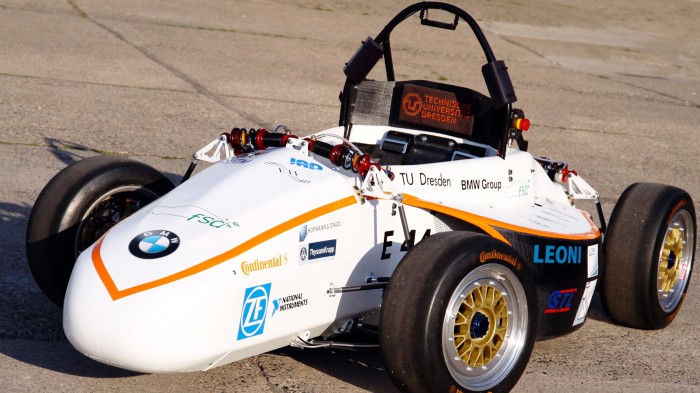Areus

Eckdaten
| Gewicht: | 336 kg |
| Leistung: | 2 x 30 kW |
| Spannung: | 435 V |
| Beschleunigung (0-100 km/h): | 4,2 sek |
| Höchstgeschwindigkeit: | 120 km/h |
Chassis
Das Chassis des Fahrzeugs besteht aus einem kohlenstofffaserverstärkten Kunststoff (CFK) – Monocoque, welches aus zwei Halbschalen gefertigt wurde. Es beherbergt neben dem Fahrer auch die Antriebsmotoren, Batterien und Wechselrichter von Areus. Erstmals wurde das Monocoque im VARI (engl.: Vacuum Assisted Resin Injection) Verfahren hergestellt. Hierbei wird das Harz-Härter Gemisch unter Vakuum in die Kohlefaser eingebracht. Zudem wurden Spanten und der Seitenaufprallschutz direkt in die Monocoque Struktur integriert.
Auch die Seitenkästen sind aus CFK gefertigt und als selbsttragende Konstruktion ausgelegt. Sie Verringern den Luftwiderstand und schützen Komponenten der Kühlung und der Steuerungselektronik vor Witterungseinflüssen.
Fahrwerk
Das Fahrwerk wurde speziell für die Anforderungen eines elektrischen Antriebs ausgelegt. Noch während der Konstruktionsphase wurden die kinematischen Eigenschaften des Fahrwerks mittels einer Mehrkörpersimulation (ADAMS) und Reifendaten analysiert.
Für die Gewichtsersparnis sind die Querlenker aus kohlenstofffaserverstärkter Kunststoff (CFK)-Rohren gefertigt und haben eingeklebte Aluminium Inserts. Die Radträger müssen hohen und heterodynen Kräften im Fahrbetrieb standhalten. Durch eine iterative FEM-Kalkulation konnten wir eine optimale Geometrie für die neuen Radträger finden. Im Vergleich zu unserer letzten Saison konnten wir somit eine höhere Performance erzielen und gleichzeitig eine Gewichtsersparnis von etwa 20% erreichen.
Elektrischer Antrieb
Areus wird an den Hinterrädern von zwei wassergekühlten Permanentmagnet-Synchromotoren mit einer Nennleistung von 30 kW bei einem maximalen Drehmoment von 80 Nm angetrieben. Sie zeichnen sich durch hohe Effizienz und ein geringes Trägheitsmoment aus. Beide Motoren sind auf einem Motorhalter fixiert, der auf einer Backplate sitzt. Sie versteift das Monocoque zusätzlich gegen Scherungskräfte, nimmt den Kettenantrieb auf und ermöglicht einen einfachen und schnellen Motorenausbau.
Über einen doppelten Kettenantrieb sind beide Motoren individuell ansteuerbar. So können in Kombination mit bordinternen Sensordaten die Hinterräder von Areus unterschiedlich angetrieben werden. Diese geregelte Antriebsmomentsverteilung ermöglicht höhere Kurvengeschwindigkeiten und bessere Beschleunigungen. Für ein möglichst günstiges Verhältnis von Festigkeit zu Gewicht wurden Kettenblätter und Backplate in ihrer Konstruktion topologieoptimiert.
Akkumulatoren - Energieversorgung
Um die Motoren anzusteuern und mit Strom zu versorgen, sind im Fahrzeug zwei Wechselrichter verbaut. Sie wandeln den Gleichstrom aus den Akkumulatoren in Wechselstrom um und Regeln die Stromzufuhr der Motoren. Die elektrische Energie wird aus einem selbst entwickelten Hochvoltakkumulator bezogen, der aus zwei in Reihe geschalteten Batteriecontainern besteht. Die Container sind aus kohlenstofffaserverstärktem Kunststoff (CFK) gefertigt, der mit brandhemmenden Additiven zur Minimierung der Brandgefahr versehen ist. Durch diese Lösung können die Akkumulatoren wartungsfreundlicher ein- und ausgebaut werden. In den Gehäusen selbst sind insgesamt 924 LiFePo4 Akkuzellen integriert. Sie sind der eigentliche Speicher der elektrischen Energie im Wagen. Mit je einem, an der TU Dresden entwickelten, Battery Management System (BMS) werden die Zellen überwacht und vor kritischen Zuständen bewahrt.
Elektronik
Die Elektronik des Wagens ist auch im Zuge des neuen Antriebskonzeptes komplexer und leistungsfähiger geworden. So werden über verschiedenste Sensoren eine Vielzahl von Signalen ermittelt und auf einem zentralen Bordrechner verarbeitet. Beispielsweise werden die Raddrehzahlen der vier Räder ermittelt, die Bremsdrücke vorne und hinten gemessen und über ein 6-Achs Sensormodul die Längsbeschleunigungen und Gierraten für alle drei Raumachsen ausgelesen. Speziell für das Antriebskonzept wird der Pedalwinkel über eine vierfach redundante Messung ausgelesen, da im Gegensatz zu einem Verbrennungsmotor die mechanische Rückkoppelung zum Motor fehlt. Zudem können alle Sensordaten und der aktuelle Fahrzeugzustand per WLAN von einem PC oder Notebook ausgelesen werden. Dies erlaubt es uns, bei Defekten schnelle Fehlerdiagnosen und Lösungen zu finden. Sowohl das Traction System Active Light (TSAL) als auch das Bremslicht im TUD-Design sind Eigenkonstruktionen von Elbflorace und mit LEDs bestückt.
